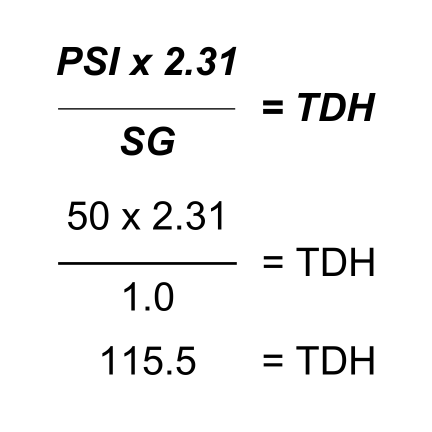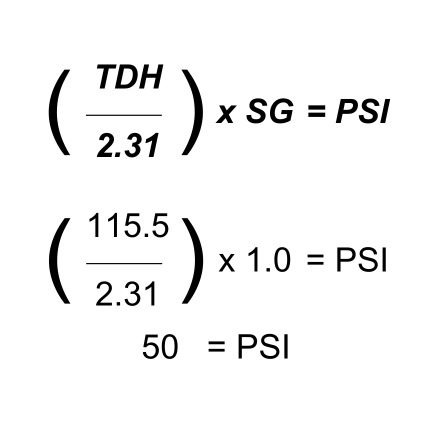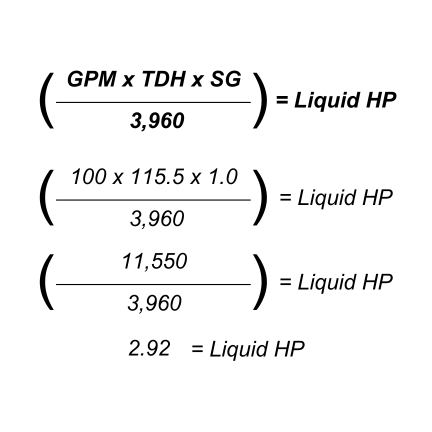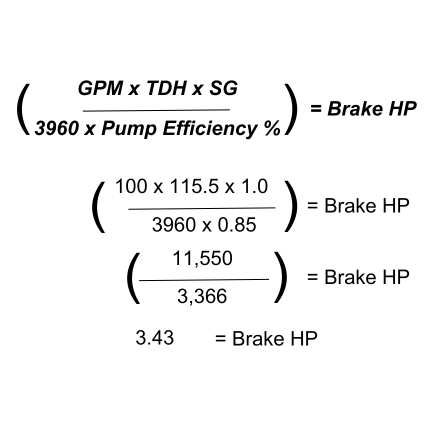We understand that when it comes to pump maintenance, you often need to perform conversions to get accurate results for a proper assessment. Have you ever found yourself searching online for formulas to fill in the gaps? Our engineers have created a handy "toolbox" of pump conversions—covering everything from specific gravity to pressure and power. These conversions are designed to help you quickly calculate what you need, so you can make informed decisions faster.
Below is our engineer's go-to guide for common pump conversions. With just a bit of math, you'll be able to order parts and solve pump issues more efficiently than ever before.
[Insert table image]
**Section 1: How to Calculate Pressure Conversions**
**How to Convert PSI to TDH**
Let’s say your system requires an additional pressure of 50 PSI, but your pump curve only shows pressure in Total Dynamic Head (TDH). How do you convert PSI to TDH?
Using the standard pressure formula, we’ve calculated this conversion using water as the fluid, which has a specific gravity (SG) of 1.0.
Start by multiplying your PSI (50) by the constant 2.31. Then divide that number by the fluid’s specific gravity (1.0). The result is 115.5 TDH, meaning you need a pump that can provide this head at your required flow rate.
 **How to Convert TDH to PSI**
You can also reverse the formula to find out what PSI corresponds to a given TDH. This is especially useful if you're reading pump curves that are based on TDH rather than pressure.
Taking the previous example where TDH equals 115.5, divide that by 2.31 and then multiply by the fluid’s SG (1.0). You’ll end up with 50 PSI, confirming the pressure your pump will deliver.
**How to Convert TDH to PSI**
You can also reverse the formula to find out what PSI corresponds to a given TDH. This is especially useful if you're reading pump curves that are based on TDH rather than pressure.
Taking the previous example where TDH equals 115.5, divide that by 2.31 and then multiply by the fluid’s SG (1.0). You’ll end up with 50 PSI, confirming the pressure your pump will deliver.
 **Section 2: How to Calculate Horsepower Conversion**
**How to Calculate Hydraulic (Liquid) Horsepower**
If you want to determine the horsepower generated by your fluid at a given flow and pressure, you need to calculate the Hydraulic Horsepower (LHP). To do this, you'll need your gallons per minute (GPM), TDH, and the specific gravity (SG) of the fluid.
In this example, GPM is 100, TDH is 115.5, and SG is 1.0 (water). Multiply these values together and then divide by 3,960. The result is 2.92 HP.
**Section 2: How to Calculate Horsepower Conversion**
**How to Calculate Hydraulic (Liquid) Horsepower**
If you want to determine the horsepower generated by your fluid at a given flow and pressure, you need to calculate the Hydraulic Horsepower (LHP). To do this, you'll need your gallons per minute (GPM), TDH, and the specific gravity (SG) of the fluid.
In this example, GPM is 100, TDH is 115.5, and SG is 1.0 (water). Multiply these values together and then divide by 3,960. The result is 2.92 HP.
 **How to Calculate Brake Horsepower**
To find the input power delivered by the motor to the pump, you need to calculate the Brake Horsepower (BHP). For this, you’ll need GPM, TDH, SG, and the pump’s efficiency (usually listed on the performance curve).
In this case, GPM is 100, TDH is 115.5, SG is 1.0, and the pump efficiency is 85%. Multiply GPM, TDH, and SG, then divide by the product of 3,960 and the efficiency (0.85). The result is 3.43 BHP.
(Hint: The difference between LHP and BHP lies in the pump efficiency. You can also divide LHP by the efficiency to get BHP.)
**How to Calculate Brake Horsepower**
To find the input power delivered by the motor to the pump, you need to calculate the Brake Horsepower (BHP). For this, you’ll need GPM, TDH, SG, and the pump’s efficiency (usually listed on the performance curve).
In this case, GPM is 100, TDH is 115.5, SG is 1.0, and the pump efficiency is 85%. Multiply GPM, TDH, and SG, then divide by the product of 3,960 and the efficiency (0.85). The result is 3.43 BHP.
(Hint: The difference between LHP and BHP lies in the pump efficiency. You can also divide LHP by the efficiency to get BHP.)
 If you'd like us to walk through other calculations or explain different scenarios, feel free to reach out—we’re here to help!
If you'd like us to walk through other calculations or explain different scenarios, feel free to reach out—we’re here to help!
 **How to Convert TDH to PSI**
You can also reverse the formula to find out what PSI corresponds to a given TDH. This is especially useful if you're reading pump curves that are based on TDH rather than pressure.
Taking the previous example where TDH equals 115.5, divide that by 2.31 and then multiply by the fluid’s SG (1.0). You’ll end up with 50 PSI, confirming the pressure your pump will deliver.
**How to Convert TDH to PSI**
You can also reverse the formula to find out what PSI corresponds to a given TDH. This is especially useful if you're reading pump curves that are based on TDH rather than pressure.
Taking the previous example where TDH equals 115.5, divide that by 2.31 and then multiply by the fluid’s SG (1.0). You’ll end up with 50 PSI, confirming the pressure your pump will deliver.
 **Section 2: How to Calculate Horsepower Conversion**
**How to Calculate Hydraulic (Liquid) Horsepower**
If you want to determine the horsepower generated by your fluid at a given flow and pressure, you need to calculate the Hydraulic Horsepower (LHP). To do this, you'll need your gallons per minute (GPM), TDH, and the specific gravity (SG) of the fluid.
In this example, GPM is 100, TDH is 115.5, and SG is 1.0 (water). Multiply these values together and then divide by 3,960. The result is 2.92 HP.
**Section 2: How to Calculate Horsepower Conversion**
**How to Calculate Hydraulic (Liquid) Horsepower**
If you want to determine the horsepower generated by your fluid at a given flow and pressure, you need to calculate the Hydraulic Horsepower (LHP). To do this, you'll need your gallons per minute (GPM), TDH, and the specific gravity (SG) of the fluid.
In this example, GPM is 100, TDH is 115.5, and SG is 1.0 (water). Multiply these values together and then divide by 3,960. The result is 2.92 HP.
 **How to Calculate Brake Horsepower**
To find the input power delivered by the motor to the pump, you need to calculate the Brake Horsepower (BHP). For this, you’ll need GPM, TDH, SG, and the pump’s efficiency (usually listed on the performance curve).
In this case, GPM is 100, TDH is 115.5, SG is 1.0, and the pump efficiency is 85%. Multiply GPM, TDH, and SG, then divide by the product of 3,960 and the efficiency (0.85). The result is 3.43 BHP.
(Hint: The difference between LHP and BHP lies in the pump efficiency. You can also divide LHP by the efficiency to get BHP.)
**How to Calculate Brake Horsepower**
To find the input power delivered by the motor to the pump, you need to calculate the Brake Horsepower (BHP). For this, you’ll need GPM, TDH, SG, and the pump’s efficiency (usually listed on the performance curve).
In this case, GPM is 100, TDH is 115.5, SG is 1.0, and the pump efficiency is 85%. Multiply GPM, TDH, and SG, then divide by the product of 3,960 and the efficiency (0.85). The result is 3.43 BHP.
(Hint: The difference between LHP and BHP lies in the pump efficiency. You can also divide LHP by the efficiency to get BHP.)
 If you'd like us to walk through other calculations or explain different scenarios, feel free to reach out—we’re here to help!
If you'd like us to walk through other calculations or explain different scenarios, feel free to reach out—we’re here to help!
TALK WITH AN EXPERTOur engineers work every day to meet our customers’ unique pump needs. Whether it's solving complex problems or ensuring your new pumps or custom solutions fit perfectly into your system, we’re here to help. Double-check your calculations with one of our experts today. |
Contact Us |
The Toyota Corolla Cross is a compact crossover SUV that combines the reliability and practicality of the iconic Toyota Corolla with the versatility and higher ground clearance of an SUV. Introduced to cater to the growing demand for compact crossovers, the Corolla Cross offers an ideal balance of style, functionality, and affordability.
The exterior design of the Corolla Cross is modern and sleek, featuring a bold front grille, sharp headlights, and a dynamic profile. Its elevated stance gives it the SUV feel while still maintaining a compact size, making it ideal for city driving and tight parking situations. The crossover's rugged styling elements, such as roof rails and a durable rear bumper, emphasize its versatility for outdoor adventures.
Inside, the Corolla Cross offers a spacious and comfortable cabin with high-quality materials and a modern layout. The interior includes a user-friendly infotainment system, featuring a touchscreen display, Apple CarPlay, Android Auto, and available safety features like Toyota Safety Sense. The cabin is designed to provide ample legroom for passengers in both the front and rear seats, along with a generous cargo space for luggage or other items.
Under the hood, the Corolla Cross is available with a fuel-efficient 1.8-liter 4-cylinder engine, providing a balance of performance and economy. There is also a hybrid variant, which offers improved fuel efficiency and lower emissions, making it an attractive option for eco-conscious drivers.
The Toyota Corolla Cross is equipped with advanced safety technologies, including lane-keeping assist, adaptive cruise control, and automatic emergency braking. These features, along with Toyota's reputation for reliability, make the Corolla Cross a safe and dependable choice for drivers seeking a practical crossover SUV.
Overall, the Toyota Corolla Cross is a versatile, stylish, and economical option for those looking for a compact SUV that blends the best of Toyota's performance, safety, and technology.
Toyota Corolla Cross Car,Toyota Corolla Cross Hybrid,corolla cross suv,2023 corolla cross
Henan Wangdao Automobile Service Co., Ltd. , https://www.wangdaocars.com